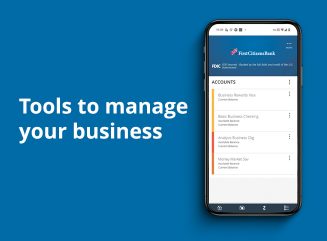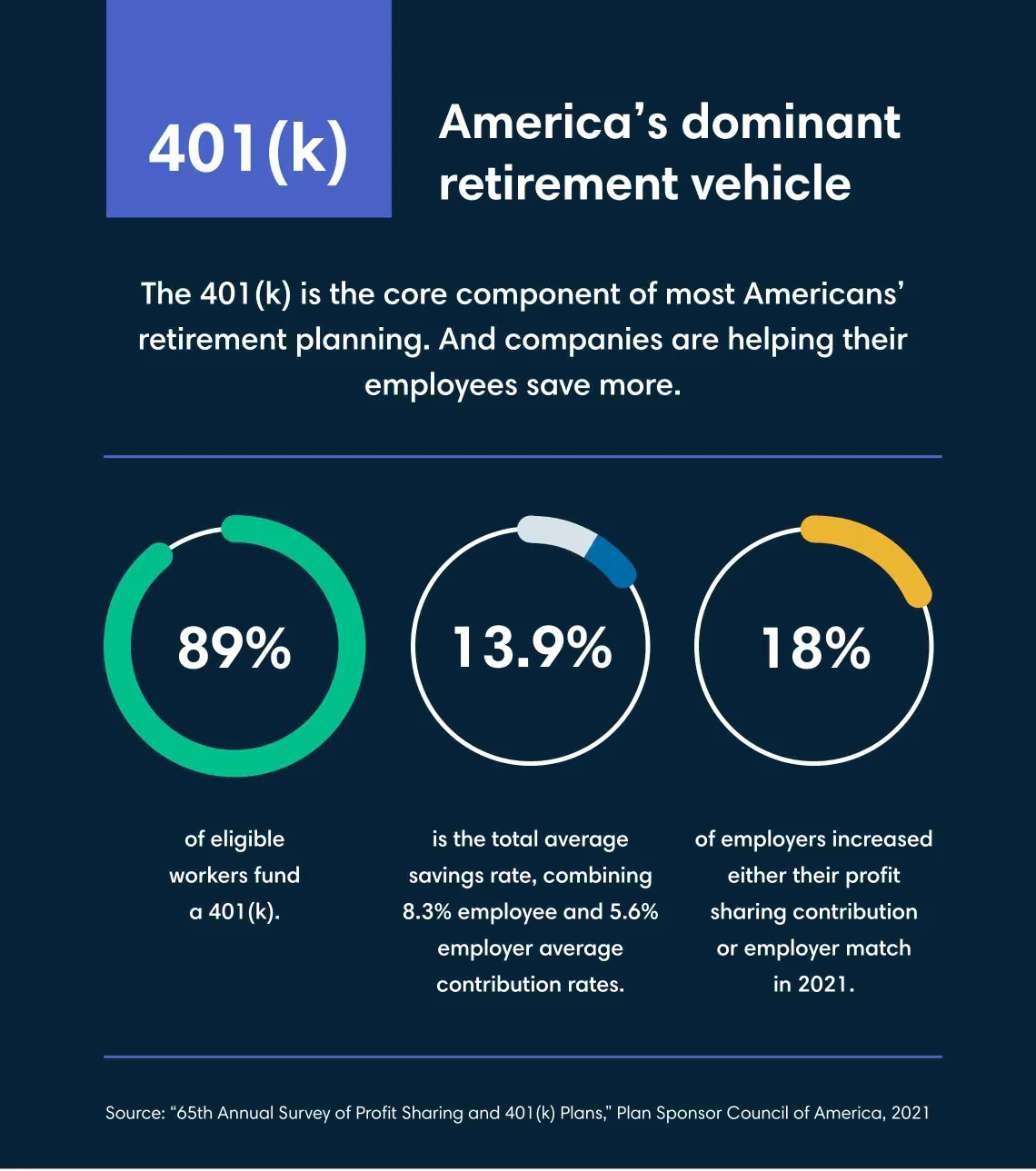Digital banking for business
Seamlessly access all of your accounts from one place with First Citizens Digital Banking for business.

Invest how you want, when you want, in real time with Self-Directed Investing.

Seamlessly access all of your accounts from one place with First Citizens Digital Banking for business.
We're committed to serving companies as they expand and succeed. The proof is in our success stories.
2026 Market Outlook video: Available now
The Making Sense team reflects on 2025 and discusses key headwinds and tailwinds for 2026.
If you know one word associated with retirement planning, chances are it's 401(k). Since their introduction in the 1970s, 401(k) plans have become the go-to qualified retirement plans offered by most employers. A recent report from Investment Company Institute shows 60 million employees are enrolled in 401(k)s, and all combined plans total $6.3 trillion in assets.

While a 401(k) is designed to be simple to open and pay into, its tax advantages aren't always the best fit. Because withdrawals are taxed at high ordinary income tax rates, it may be possible for higher income savers to hurt themselves in the long run by putting too much in their 401(k) and too little in more tax-favorable account types.
To help fine-tune your 401(k) funding approach, we've brought in First Citizens Wealth Planning Director Mike Deming.
As you determine the right amount to contribute to your 401(k), you may make some common assumptions. The notion that retirement planning is limited to opening a 401(k) may lead to you to put as much money into it as you can without considering alternatives.
"To be clear, a 401(k) should be a primary part of an employee's retirement planning," he says. "But budgeting your whole retirement around $1 million put into a traditional 401(k), without factoring in taxes on required minimum distributions and other withdrawals, can lead to a real shock when you begin drawing on the account."
The same goes for other assumptions, such as believing you'll be in a lower tax bracket in retirement or that your expenses will be lower after you retire.
"Thinking Congress won't alter the tax brackets at some point, inflation will stay low or your health won't change—it all amounts to predicting the future," says Deming. "You just can't make those assumptions and expect to have a secure, adequately funded retirement—especially if you've got all your investments concentrated in a single 401(k)."

The 401(k) is the core component of most Americans' retirement planning. And companies are helping their employees save more.
Source: "65th Annual Survey of Profit Sharing and 401(k) Plans," Plan Sponsor of America, 2021
The chief way to unlearn those assumptions and find your perfect 401(k) investment level is by expanding your retirement funding mindset. Add varied financial pieces that build a model retirement portfolio and then holistically budget for your needs to know exactly how much you should contribute to your 401(k).
Deming suggests five steps for achieving this, each working together to strengthen your overall retirement readiness.
The type of 401(k) plan you pick will influence the structure of your contributions. Most employers offer a traditional 401(k). These, along with other options like SIMPLE 401(k) plans, safe harbor 401(k) plans and 403(b) plans, are tax-deferred accounts that offer pretax contributions and growth, with taxes paid at regular income tax levels when money is withdrawn.
Close to 90% of employer-sponsored plans also offer a Roth 401(k), which flips the tax situation in reverse—you pay taxes on your contributions, but withdrawals are tax-free as long as applicable rules are followed. This after-tax workplace plan is modeled on the Roth IRA.
"With a Roth 401(k), you pay the taxes up front and don't get the annual tax deduction that traditional 401(k)s offer," says Deming. "The advantage is that with taxes already paid, you don't have to worry about rising tax rates, and none of the growth from your investments is taxed. So if you can start with, or switch to, a Roth 401(k), a bit of sacrifice in the present is likely to set you up with more money down the road."
High-interest debt impacts your ability to build wealth and efficiently fund all your investments, including your 401(k). One more assumption you can't afford to make is that debt can be dealt with down the road. What's better than a 401(k) that's maxed out every year? Little or no high-interest debt.
"Once you've set up your 401(k), your highest priority should be addressing high-interest debt," he says. "If you can, consolidate it, and no matter what, make a specific program to eliminate it. To be clear, you should eliminate all debt, focusing on high-interest debt most urgently. Do not just move it around or make minimum payments. Because as long as debt sticks around, it's a big obstacle to your plans—both in retirement and the present."
This tip is closely related to the last one: Having cash for an emergency can prevent you from turning to a credit card or personal loan when you have an unexpected expense or want to find space in your budget to increase your retirement account contributions.
"Set your emergency savings fund up with 3 to 6 months of cash or cash equivalents in a high-yield savings account, laddered CDs or another cash or cash-equivalent option," says Deming. "If you're just starting your career and are tight for money, make an effort to fund your 401(k) at low levels like 2% to 3% so that you can set enough aside to also expand your savings."
Similar to a 401(k), a health savings account, or HSA, is a pretax investment vehicle that's meant to help defray out-of-pocket healthcare costs but can double as a powerful retirement savings augmentation tool. Unlike a 401(k), an HSA never requires minimum distributions. It's exempt from Social Security and Medicare taxes. And all withdrawals are tax-free as long as they're used for medical costs, which makes it a viable tax management vehicle.
You need a high-deductible health insurance plan to qualify to open and fund an HSA. "It gives you an investment account that can cover post-work healthcare costs without dipping into your 401(k) and provides a completely tax-advantaged source of funds to cover one of the costliest aspects of retirement," he says.
HSAs offer several tax advantages:
"Maxing out your HSA on a yearly basis should be a top priority—and if at all possible current medical expenses should be covered from other sources," Deming says. Doing so, he says, will allow tax-advantaged HSA accounts to remain intact and grow as much as possible so they can be used later in retirement to cover medical expenses.
The tax advantages of a 401(k) come with conditions. That's why it can be beneficial to have an additional source of retirement income that isn't subject to early withdrawal penalties before retirement, isn't subject to required minimum distributions and isn't taxed at regular income tax rates.
Brokerage accounts let you invest in securities, such as stocks and bonds, that limit your income tax exposure only to paid-out dividends. Any gains you make on your initial investment may be taxed at much lower long-term capital gains rates, if you hold the investment long enough. Losses can be tax deductible. And because you have control over the timing of your purchases and sales, you also have some control over when you pay any tax owed.
Other types of brokerage account investments, such as mutual funds, offer slightly less tax control for their investors because capital gains and dividends that are incurred within the fund's holdings are passed along to shareholders in the fund, who must pay taxes on them at the end of each year. But, as with stocks and other investments, any profits made on the sale of mutual fund shares may be taxed at long-term capital gain rates, which are much lower than ordinary income tax rates for many taxpayers.
Due to the complexity of taxation on brokerage account investments, you should always consult with a tax expert along with your financial advisor as you manage your investments. But investing through a taxable brokerage account can be a powerful addition to your overall retirement strategy.
"Brokerage accounts should absolutely be included in your retirement plan," Deming says. "It might involve treasury instruments or something that's more long-term, but it's one of the investment pieces that you need—and after setting it up, you'll have a much better idea of how much you should fund your 401(k)."
Another caution is also in order. There are built-in incentives for you to leave your money invested for the long term in a 401(k), because tax rates on withdrawals are high and stiff penalties may apply if you're under the age of 59 1/2. It may require a good deal more self-discipline for you to avoid spending money from a brokerage account, where the taxes tend to be lighter and no significant withdrawal penalties exist.
After tallying the numbers on the new additions and adjustments, you'll be able to draw up a realistic 401(k) contribution level that aligns with your expanded retirement funding plan. While no two budgets will be the same, a few pointers apply in almost every scenario.
"No matter what number you come up with, if your employer has a 401(k) match threshold, then your initial funding goal should work to hit or exceed that match," says Deming. "If your finances don't allow for that right away, that's okay. Fund what you can. Even if it's just 3%, put that in and let compounding build your balance."
Where can you get the money to make those increases once you've added other accounts to your retirement strategy? "If you get a raise or a bonus, as tempting as it is, don't even think about spending it," he says. "A 2% pay increase should be used to bump up your traditional or Roth 401(k) contribution a percentage point every time you get a raise."
"And if you need a bit of help balancing out those new additions and readjustments to find your specific figure, a bit of professional know-how is always good for making the pieces fit."



The information provided should not be considered as tax or legal advice. Please consult with your tax advisor.
Your investments in securities and insurance products and services are not insured by the FDIC or any other federal government agency and may lose value. They are not deposits or other obligations of, or guaranteed by any bank or bank affiliate and are subject to investment risks, including possible loss of the principal amounts invested. There is no guarantee that a strategy will achieve its objective.
About the Entities, Brands and Services Offered: First Citizens Wealth® (FCW) is a registered trademark of First Citizens BancShares, Inc., a bank holding company. The following affiliates of First Citizens BancShares are the entities through which FCW products are offered. Brokerage products and services are offered through First Citizens Investor Services, Inc. ("FCIS"), a registered broker-dealer, Member FINRA and SIPC. Advisory services are offered through FCIS, First Citizens Asset Management, Inc. and SVB Wealth LLC, all SEC registered investment advisors. Certain brokerage and advisory products and services may not be available from all investment professionals, in all jurisdictions or to all investors. Insurance products and services are offered through FCIS, a licensed insurance agency. Banking, lending, trust products and services, and certain insurance products and services are offered by First-Citizens Bank & Trust Company, Member FDIC and an Equal Housing Lender icon: sys-ehl, and First Citizens Delaware Trust Company.
For more information about FCIS, FCAM or SVBW and its investment professionals, visit FirstCitizens.com/Wealth/Disclosures.
See more about First Citizens Investor Services, Inc. and our investment professionals at FINRA BrokerCheck.
This material is for informational purposes only and is not intended to be an offer, specific investment strategy, recommendation or solicitation to purchase or sell any security or insurance product, and should not be construed as legal, tax or accounting advice. Please consult with your legal or tax advisor regarding the particular facts and circumstances of your situation prior to making any financial decision. While we believe that the information presented is from reliable sources, we do not represent, warrant or guarantee that it is accurate or complete.
Third parties mentioned are not affiliated with First-Citizens Bank & Trust Company.
Links to third-party websites may have a privacy policy different from First Citizens Bank and may provide less security than this website. First Citizens Bank and its affiliates are not responsible for the products, services and content on any third-party website.
First Citizens Bank is a Member FDIC and an Equal Housing Lender icon: sys-ehl.
NMLSR ID 503941

Treasury & Cash Management
Electronic Bill Presentment & Payment
Investment & Retirement Services
Community Association Banking
Equipment Financing & Leasing
Credit Cards
Merchant Services
Email Us
Please select the option that best matches your needs.
Customers with account-related questions who aren't enrolled in Digital Banking or who would prefer to talk with someone can call us directly.